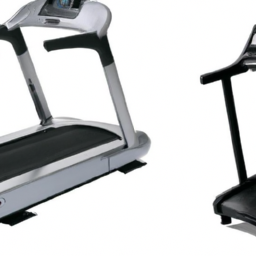Treadmills are a staple in many fitness routines, allowing individuals to exercise from the comfort of their own homes. But have you ever wondered just how fast these machines can go? Whether you’re a beginner looking for a moderate pace or a seasoned athlete craving a vigorous workout, knowing the top speeds of treadmills can guide your fitness journey. In this article, we’ll explore the varying speeds of treadmills and help you determine which one is best suited for your exercise needs. Get ready to lace up your shoes and find out just how fast a treadmill can go!
Factors that Determine Treadmill Speed
When it comes to determining the speed of a treadmill, there are several factors that come into play. These factors can vary depending on the type of treadmill and its intended use. Here are some key factors that influence treadmill speed:
Motor Power
The motor power of a treadmill is perhaps the most important factor when it comes to determining its speed capabilities. The more powerful the motor, the faster the treadmill can go. Most home treadmills have motors ranging from 1.5 to 3.0 horsepower, while commercial treadmills can have motors as powerful as 5.0 horsepower or more. A higher horsepower motor allows the treadmill to reach higher speeds and maintain them without strain.
Belt Length and Width
The length and width of the treadmill belt also play a role in its speed capabilities. Longer and wider belts provide more room for a comfortable stride and allow for higher speeds. The standard belt length for most home treadmills is around 55 to 60 inches, while commercial treadmills may have belts that are 60 inches or longer. A wider belt, typically 20 to 22 inches, provides added stability and ensures a smooth and safe running experience at higher speeds.
Incline Function
The incline function of a treadmill can also affect its speed capabilities. When the treadmill is set at an incline, it creates resistance and can impact how fast you’re able to run. Running uphill requires more effort and may limit the top speed of the treadmill. However, some advanced treadmills have incline features that can be adjusted while maintaining high speeds, allowing for challenging uphill sprints.
User Weight Limit
The weight limit of a treadmill is another important consideration when it comes to speed. Higher weight limits generally indicate a more robust and durable treadmill that can handle faster speeds. Treadmills with lower weight limits may not be designed to accommodate high-speed running. It is crucial to adhere to the weight limit guidelines provided by the manufacturer to ensure the safety and longevity of the treadmill.
Common Speed Range for Home Treadmills
Home treadmills usually have a range of speeds that cater to different fitness levels and goals. The common speed range for home treadmills typically falls within the following categories:
0-10 mph
A speed range of 0-10 mph is ideal for beginners and individuals who prefer to walk or jog at a moderate pace. This range accommodates a wide range of fitness levels and allows for brisk walking, light jogging, and even some interval training.
0-12 mph
For more advanced users, a treadmill with a speed range of 0-12 mph provides additional options for faster running. This range is suitable for individuals who engage in moderate to high-intensity workouts, including steady-state running, interval training, and sprint workouts.
0-15 mph
Treadmills with a top speed of 0-15 mph are designed for serious runners and athletes who want to push their limits. This speed range allows for higher intensity interval training, sprinting, and simulating race pace workouts. It provides a challenging environment for those looking to improve their speed and endurance.

Commercial Treadmills: Higher Speed Options
Commercial treadmills are often found in gyms and fitness centers and are built to withstand heavy use. These treadmills offer higher speed options to cater to the needs of professional athletes and serious runners. Here are some common speed options for commercial treadmills:
0-20 mph
Commercial treadmills frequently feature a speed range of 0-20 mph. This wide range accommodates a variety of workout intensities and allows users to challenge their speed limits. It is particularly beneficial for sprinters and athletes who require high-speed training.
0-25 mph
For those seeking even greater speed capabilities, commercial treadmills with a range of 0-25 mph are popular choices. This extends the upper limit of speed and provides exceptional training opportunities for advanced runners and athletes.
0-30 mph
For elite athletes and professional runners, commercial treadmills that can reach speeds of 0-30 mph are available. These treadmills are designed to simulate extreme race scenarios and accommodate top-level speed training. They offer unparalleled speed options for those who require the most challenging workouts.
Understanding Speed Metrics on Treadmills
Treadmills typically provide speed metrics in different units to accommodate different preferences and geographical locations. Understanding these speed metrics can help you accurately track and measure your workouts. Here are the three most common speed metrics you’ll find on treadmills:
MPH (Miles Per Hour)
Miles per hour (MPH) is the standard unit of speed used in the United States and some other countries. This metric measures how many miles you can cover in an hour. For example, running at 5 mph means you are covering a distance of 5 miles in one hour.
KPH (Kilometers Per Hour)
Kilometers per hour (KPH) is the standard unit of speed used in most countries outside of the United States. As the name suggests, KPH measures how many kilometers you can cover in an hour. To give you an idea, running at 10 KPH means you are covering a distance of 10 kilometers in one hour.
Pace (Minutes Per Mile)
Pace is another common speed metric used by runners. It refers to the time it takes to cover one mile. For example, a pace of 8 minutes per mile means it takes you 8 minutes to run one mile.
Understanding these speed metrics can help you monitor your progress, set goals, and compare your performance with others, regardless of the unit of measurement used on your treadmill.

Benefits of Higher Speed Treadmills
Investing in a treadmill with higher speed capabilities can offer several benefits for your fitness journey. Here are some advantages of using higher speed treadmills:
Increased Calorie Burn
Running at higher speeds requires more energy expenditure, resulting in a higher calorie burn. By incorporating faster running into your workouts, you can effectively increase the number of calories you burn during each session. This can be especially beneficial for individuals looking to lose weight or improve their overall cardiovascular fitness.
Improved Cardiovascular Endurance
Running at higher speeds pushes your cardiovascular system to work harder. With regular high-speed treadmill workouts, your heart and lungs become more efficient at delivering oxygen to your muscles. This can lead to improved cardiovascular endurance, allowing you to run longer distances at a faster pace.
Interval Training Potential
Higher speed treadmills provide an excellent platform for interval training, a method of alternating between intense bursts of speed and active recovery periods. This type of training has been shown to improve cardiovascular fitness, increase speed, and enhance overall performance. With a treadmill that offers higher speeds, you have the opportunity to push yourself during the intense intervals and recover actively during the slower phases.
By incorporating interval training into your treadmill workouts, you can optimize your time, challenge your body, and achieve significant improvements in your fitness level.
Safety Considerations for High-Speed Treadmills
While high-speed treadmills can offer exceptional training opportunities, it’s crucial to prioritize safety when using them. Here are some important safety considerations to keep in mind when using high-speed treadmills:
Proper Warm-Up and Cool-Down
Before engaging in high-speed treadmill workouts, ensure that you properly warm up your muscles and prepare your body for the intensity ahead. Warm-up exercises such as dynamic stretches and light jogging can increase blood flow to your muscles, improve flexibility, and reduce the risk of injury. Similarly, cooling down with gentle exercises and stretches after your workout can help your body recover and prevent muscle soreness.
Maintaining Good Running Form
Running at high speeds requires proper running form to ensure efficiency and reduce the risk of injury. Focus on maintaining an upright posture, engaging your core, and landing with a midfoot strike. Avoid overstriding, excessive heel striking, or leaning too far forward. Good running form helps distribute the impact evenly and reduces the strain on your joints and muscles.
Gradual Speed Progression
When incorporating high-speed running into your treadmill workouts, it’s essential to progress gradually. Sudden increases in speed can increase the risk of injuries such as muscle strains or sprains. Start with a comfortable pace and gradually increase your speed as your body adapts and becomes stronger. Listen to your body and respect its limits to avoid unnecessary injuries.
By following these safety considerations, you can make the most of your high-speed treadmill workouts while minimizing the risk of injuries.

This image is property of boxlifemagazine.com.
Training Programs and Workouts for High-Speed Treadmills
Now that you understand the benefits and safety measures associated with high-speed treadmill workouts, let’s explore some training programs and workouts you can incorporate into your routine:
Sprint Intervals
Sprint intervals are short bursts of intense running followed by recovery periods. To perform sprint intervals on a high-speed treadmill, start with a warm-up jog, then gradually increase the speed to sprint level (e.g., 9-12 mph) for 30-60 seconds. Follow each sprint with a recovery period of 1-2 minutes of slow jogging or walking. Repeat the cycle for a designated number of sets, gradually increasing the duration and intensity as your fitness improves.
Fartlek Training
Fartlek training involves alternating between periods of easy running and faster-paced intervals. With a high-speed treadmill, you can blend different speeds seamlessly. Start with an easy warm-up jog, then vary your speed throughout the workout. For example, you can alternate between 6-8 mph for two minutes, then increase to 10-12 mph for one minute. Continue this pattern throughout your workout, adjusting the intensity based on your fitness goals and capabilities.
Tempo Runs
Tempo runs are sustained runs at a comfortably hard pace, usually at or near race pace. Incorporating tempo runs into your high-speed treadmill workouts is an effective way to improve your endurance and stamina. Start with a warm-up jog, then increase your speed to a pace that is challenging but sustainable for an extended period. Aim to maintain this pace for 10-20 minutes, and then gradually decrease the speed for a cool-down jog.
These training programs and workouts can help you maximize the benefits of high-speed treadmill running and keep your workouts challenging and exciting.
Comparing Treadmill Speeds with Outdoor Running
When considering treadmill speeds, it’s important to note the differences between treadmill running and outdoor running. Here are some factors to consider when comparing treadmill speeds with outdoor running:
Impact on Running Form
Running on a treadmill provides a more controlled and consistent surface than outdoor running. Without the variabilities of outdoor terrain, it’s generally easier to maintain a consistent running form on a treadmill. However, it’s essential to transition your runs outdoors occasionally to adapt to the different surfaces and challenges that come with outdoor running.
Environmental Factors
Outdoor running exposes you to various environmental factors such as wind, temperature, and humidity. These factors can affect your performance and perceived effort level. On a treadmill, you’re in a controlled environment where factors like wind resistance and temperature are eliminated. This means that your treadmill speeds may not directly translate to the same effort level or pace outdoors.
Surface Variations
Treadmill surfaces are typically cushioned to minimize impact on your joints, making them more forgiving than outdoor surfaces. While this can be beneficial for reducing the risk of injuries, it’s important to remember that outdoor running on different surfaces, such as pavement or trails, may require additional adaptations. Varying your running surfaces can help improve your running efficiency and minimize the risk of overuse injuries.
By considering these factors, you can better understand the similarities and differences between treadmill speeds and outdoor running. Remember to adjust your expectations and goals accordingly based on the environment in which you are running.

This image is property of ucarecdn.com.
Additional Features to Enhance Treadmill Speed Workouts
To enhance your treadmill speed workouts and make them more engaging and effective, many treadmills offer additional features. Here are some features to look for when selecting a treadmill for speed training:
Quick Speed Controls
Treadmills with quick speed controls allow you to easily adjust the speed during your workouts. This feature eliminates the need to repeatedly press buttons to gradually increase or decrease your speed. With quick speed controls, you can quickly and seamlessly transition between different speeds, enhancing the efficiency and fluidity of your workouts.
Pre-set Speed Programs
Many treadmills come with pre-set speed programs designed to challenge and guide your workouts. These programs may include interval training, hill workouts, or speed-focused sessions. By selecting a pre-set speed program, you can take the guesswork out of your training and let the treadmill guide you through various speed variations and intensities.
Realistic Outdoor Simulation
Some high-end treadmills offer features that simulate outdoor running experiences. These features may include incline and decline functions that mimic outdoor terrains, as well as interactive screens that display scenic routes. By creating a more immersive and realistic running experience, these features can enhance your motivation and engagement during your high-speed treadmill workouts.
Considering these additional features can help you select a treadmill that caters to your specific needs and preferences, making your speed workouts more enjoyable and effective.
Conclusion
The speed capabilities of a treadmill are determined by various factors such as motor power, belt length and width, incline function, and user weight limit. Home treadmills commonly have speed ranges of 0-10 mph, 0-12 mph, and 0-15 mph. Commercial treadmills offer even higher speed options, ranging from 0-20 mph to 0-30 mph, catering to the needs of professional athletes and serious runners.
Understanding speed metrics like MPH, KPH, and pace can help you accurately monitor and measure your treadmill workouts. High-speed treadmills offer benefits such as increased calorie burn, improved cardiovascular endurance, and interval training potential. However, safety considerations, including proper warm-up and cool-down, maintaining good running form, and gradually progressing speed, are crucial when using high-speed treadmills.
Training programs and workouts like sprint intervals, fartlek training, and tempo runs can be incorporated into high-speed treadmill workouts to enhance performance and fitness. It’s essential to consider the differences between treadmill speeds and outdoor running, including the impact on running form, environmental factors, and surface variations.
Additional features such as quick speed controls, pre-set speed programs, and realistic outdoor simulation can enhance the effectiveness and enjoyment of treadmill speed workouts. By taking into account all these factors and considerations, you can optimize your high-speed treadmill training and achieve your fitness goals.





